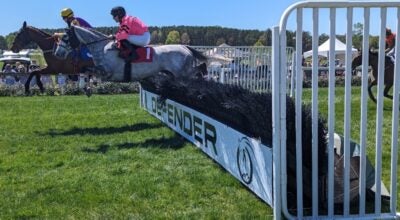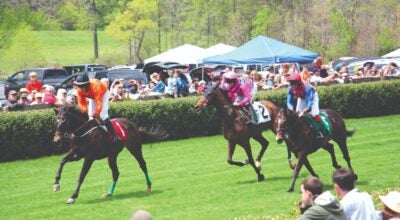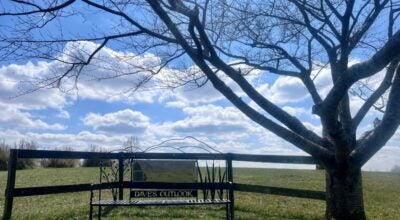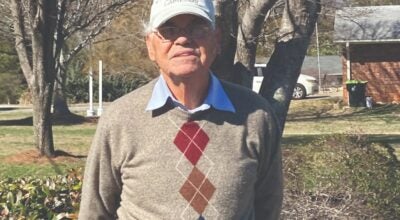Bring in the cavalry
Published 11:00 pm Wednesday, January 31, 2018
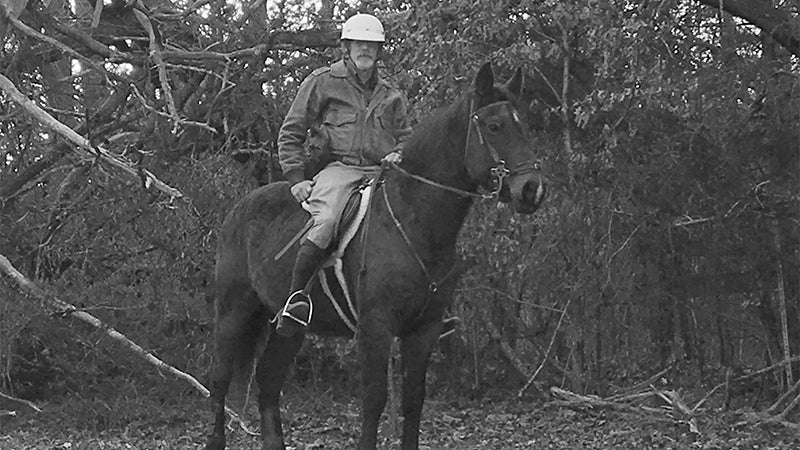
- Dan Gilmore of Columbus in cavalry dress typically used in WWII. Gilmore is part of the International Light Cavalry Association that works to preserve the history of military riding. (photo submitted by Dan Gilmore)
Imagine riding a dressage test using only one hand on the reins, shooting a pistol while jumping or spearing a ring with a lance while riding at a full gallop. These are some of the fun events practiced and preserved today by the International Light Cavalry Association.
Columbus resident Dan Gilmore is part of this ten-year-old organization dedicated to the research and preservation of cavalry techniques used in riding. The association, which spans the globe, includes groups in the US, and sponsors authentic cavalry style competitions.
“Our goal is to bring people together and preserve the cavalry tradition,” said Gilmore. “We’re about keeping the techniques of military riding alive and creating an awareness that it’s still being practiced.”
According to Gilmore, the group focuses on the time from the Napoleonic Wars through the dissolution of the European cavalries shortly after WWII. The association is somewhat loosely connected. Similar to historical reenacting groups, they stay in touch mostly through Facebook and events.
European competitions can have as many as 600 or more participants. Those participating in US events are typically cavalry reenactors from the Revolutionary War to the dissolution of the US cavalry in the 1930s.
Their events range from military style three-day cross-training competitions, similar to today’s combined training competitions to period military balls in formal dress uniforms.
While their events include three-day combined training style competition there are some notable differences between Fédération Equestre Internationale (FEI) combined training competitions and the Cavalry Association’s competitions. In the association’s mounted competitions, the dressage test and the stadium jumping are ridden with only one hand on the reins rather than two. The horses are often ridden in military bridles, which include a Pelham bit with two reins rather than a double bridle. The cross-country course distance is similar to the modern day eventing cross-country preliminary level, however the fences are more natural looking.
The competitions also include events such as tent pegging in which the rider uses a lance to spear a sand bag on the ground, the ring tilt, in which the rider uses a lance to spear rings from a post, or running at “heads” (gourds) with a sabre. They also practice mounted shooting (using air pistols) through a course in the ring or over jumps.
Another popular event is the old style military cross-country rides, which can be anywhere from 10 to 30 miles and are ridden at specific gaits. The course calls for a walk through a certain area and trot or slow gallop for specified times or distances. The course will cover several different types of terrain, including jumping and crossing water.
The events are all ridden in military style uniforms with authentic period style equipment. Though most participants are men, women are welcomed, and, unlike most reenacting groups, the women are not required to disguise themselves as men.
Gilmore said in addition to the cavalry competitions, members engage in historical research and discussions, riding instruction, and helping people acquire uniforms and equipment relating to different periods in history.
Their discussions include different styles and systems of riding from classical dressage to forward riding. “You can get some lively discussions on Facebook,” he said with a light chuckle. “Just mention the benefits of forward seat verses balanced seat and you can start a war.”
Gilmore is a big fan of the forward riding techniques described by Captain Federico Caprilli in the Italian cavalry manual from the late 1800s. Whereas today’s modern seat, based on George Morris’ version of the forward seat known as hunt seat, is designed for the game of competing, Gilmore said the military forward seat was about getting from point A to point B without wearing out the horse and rider.
“The military forward seat that Caprilli codified and detailed was specifically about preservation of the horse and rider in the field,” said Gilmore. “Caprilli’s instruction was based on riding in an uncontrolled situation that was often chaotic. This could help today’s riders in such events as endurance, riding or fox hunting.”
Gilmore added that the forward seat was also designed to train horses and riders more quickly and efficiently so they could go into the field as soon as possible.
“The old system [classical dressage] took years to train a rider and horse effectively,” said Gilmore adding that classical dressage was not a style of training that fit the needs of modern cavalry. “Like Littauer [Vladimir Littauer, author of The Development of Modern Riding, Common Sense Horsemanship and other books on forward riding] said, once the melee begins, refinement and fancy maneuvers go out the window.”
Gilmore grew up in a military family and learned to ride from his grandfathers and great uncles who were former cavalrymen. He holds degrees in history and economics and uses his language skills to translate some of Caprilli’s texts into English, some of which have been published in Equus Magazine.
With his father working for the Department of Defense, Gilmore grew up all over the US, then moved to Columbus in 1990 with his wife Elizabeth (EW) Cooper. Cooper is also a horsewoman, having galloped racehorses and worked for the Charleston Mounted Patrol. She also hunted with the Tryon and Green Creek Hounds.
For more information on the International Light Cavalry Association visit their Facebook page or the Eastern Seaboard Cavalry Association Facebook page.
Catherine Hunter’s journalism career spans 20 years of writing for
newspapers and magazines, including The Chronicle of the Horse, The Western Horseman, the Tryon Daily Bulletin and Foothills Magazine. In 2000, Hunter received a South Carolina Press Association award for reporting in depth. She is the author of “Sacred Connections Horsemanship: Empowering Horse and Rider through Chakra Energy.” Email her at
catherine.hunter@tryondailybulletin.com.


